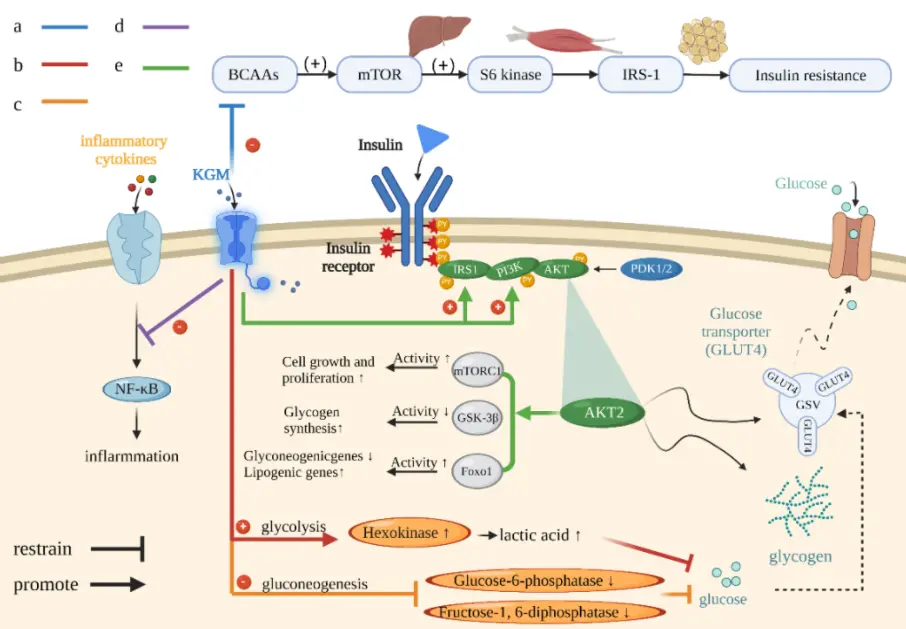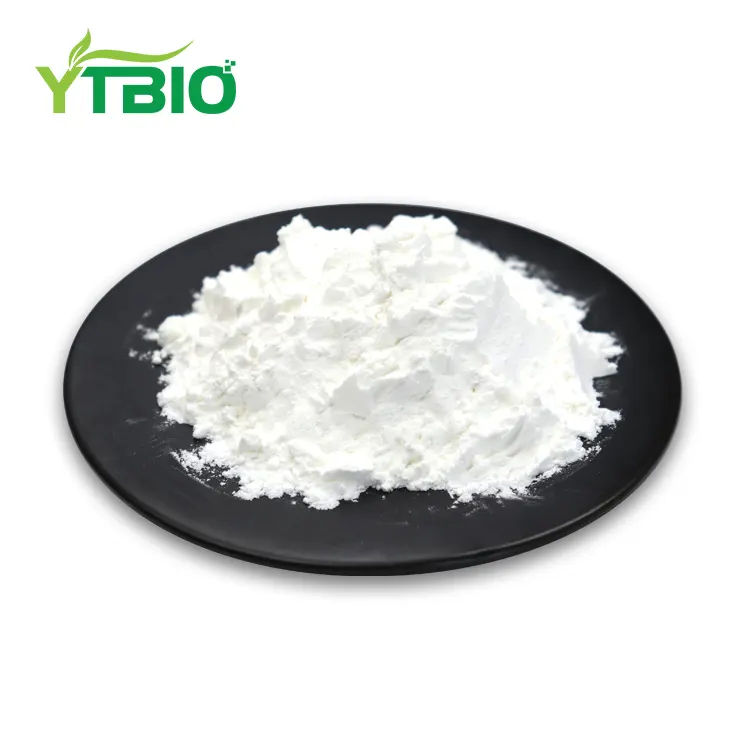KGM Konjac Glucomannan
Source: Konjac
Specifications: Glucomannan 85%,Viscosity>22000
Detection method: HPLC
Particle Size: 95% pass 120 mesh
Storage:Cool dry place,away from heat and strong light
Shipping speed:3-5 days
Certificates:cGMP,ISO22000,ISO9001,EU&NOP Organic Certificate,Kosher,BRC,Halal,HACCP
Package:25Kg/barrel
- Fast Delievery
- Quality Assurance
- 24/7 Customer Service
Product Introduction
Do You Know About KGM Konjac Glucomannan?
Konjac is a staple food in China, Japan, and many parts of Southeast Asia. It is considered to have important medicinal properties in my country. Konjac's main component is glucomannan, a white powder.
KGM Konjac glucomannan is a high-molecular-weight soluble dietary fiber composed of glucose and mannose linked by β-1,4-glycosidic bonds in a ratio of 1:1.6. It contains 5-10% acetyl groups. It has high viscosity, strong water absorption, and gelling properties, with a 1% aqueous solution forming a stable sol system. KGM's core functions include delaying glucose absorption, reducing cholesterol intake, enhancing satiety, regulating blood sugar and lipids, improving gut flora health, and preventing constipation. Studies have shown that it can aid in the treatment of metabolic diseases such as obesity and diabetes. KGM can be used as a food additive in noodle and meat processing, but its purity is limited. In recent years, through modification techniques such as deacetylation and esterification, as well as physical purification processes, its active ingredient content has been significantly increased, leading to the development of high-purity tablets, granules, and low-calorie functional foods.

Konjac glucomannan (KGM) is currently widely used in the food industry, as well as cosmetics, biopharmaceuticals and other fields.
YTBIO: Provide You With High Quality KGM Konjac Glucomannan

What Are The Properties Of KGM Konjac Glucomannan?
Thickening and gelling properties are two key characteristics of konjac glucomannan. It can absorb approximately 100 times its own volume in water, forming supramolecules through hydrogen bonding and dipole interactions with water molecules, resulting in excellent thickening properties. Konjac glucomannan is one of the few polysaccharide macromolecules capable of forming highly elastic, thermally irreversible physical hydrogels. It has long been used as a thickener and gelling agent in a wide range of applications in food, medicine, and chemical industries, serving as a highly effective texture enhancer and rheological modifier.
In fact, konjac glucomannan's functions extend far beyond this.
Physiological Functions
Konjac glucomannan is a natural, high-molecular-weight soluble dietary fiber, a superior dietary fiber. It is calorie-free, provides a sense of satiety, reduces and delays glucose absorption, inhibits fatty acid synthesis, and has excellent fat-reducing and lipid-lowering effects.
Improves glucose absorption and lipid metabolism
Konjac glucomannan does not contain any hydrolytic enzymes in the human body and is virtually calorie-free. It absorbs water and swells in the body, increasing satiety and slowing glucose absorption. Konjac glucomannan can also improve insulin sensitivity, improve glucose tolerance, and regulate insulin homeostasis. Konjac glucomannan also influences the release of hormones in the digestive tract and is broken down by colonic microorganisms to produce propionate, which increases the body's utilization of glucose.

Glucose uptake by cells
Konjac glucomannan not only accelerates the conversion of cholesterol into bile acid by absorbing bile acid, but also directly binds to cholesterol, increasing its excretion in feces and hindering the absorption of cholesterol and fat. Furthermore, colonic fermentation produces short-chain fatty acids such as propionate, which can also help lower blood lipids.
Improves intestinal function
KGM Konjac glucomannan regulates intestinal function primarily by preventing constipation and promoting the growth of beneficial intestinal bacteria. While the human body lacks konjac glucomannanase and cannot utilize it, it can stimulate the secretion of intestinal enzymes, eliminate waste products that have long adhered to the intestines, and prevent constipation. Furthermore, konjac glucomannan can be utilized by colonic microorganisms to produce short-chain fatty acids, which stimulate intestinal motility, promote the growth of beneficial anaerobic microorganisms such as bifidobacteria, and inhibit the growth of intestinal pathogens.
Improving Immunity
As a polysaccharide, konjac glucomannan can directly activate some immune cells, thereby enhancing the body's immunity. It can also promote the growth of intestinal anaerobic bacteria such as bifidobacteria. These probiotics have a significant immune-boosting effect.
Assisting with Weight Management
Konjac glucomannan, due to its strong water-absorbing and swelling properties, fills the gastrointestinal tract, creating a feeling of fullness, thereby reducing food intake and achieving weight control. Konjac glucomannan can also reduce the activity of Na+-K+-ATPase in the small intestinal mucosa, limiting nutrient absorption. Due to its high molecular weight and viscosity, konjac glucomannan increases the viscosity of digestive chyme in the digestive tract. It also coats the surface of the intestinal mucosa, forming a diffusion barrier, slowing the retention of chyme in the stomach cavity. This limits the diffusion of nutrients from food into the intestinal villi and prolongs the digestive process.
Applications of KGM Konjac Glucomannan
Health Foods
Due to its excellent physiological properties, konjac glucomannan is increasingly being used in health foods to address various nutritional imbalances in the human body or to prevent and treat related diseases. It is most commonly used in foods for diabetics and weight management. It is also processed into various health foods, such as konjac wine, konjac beverages, and complex vitamin capsules, to help lower blood pressure and blood lipids, and enhance immunity.
Food Additives
Konjac glucomannan is commonly added as a thickener and stabilizer to foods such as bread, cakes, and beverages to improve product quality and reduce production costs. Konjac glucomannan has a high molecular weight and high viscosity, making it a foam stabilizer for beer, creating a fine and uniform foam. It can also be used as a clarifier to enhance beverage quality and as a gelling agent in jellies.
Meat Products
Konjac glucomannan has excellent emulsifying, water-binding, and gelling properties. It is often used as a fat substitute in meat products, effectively improving the texture and reducing the fat content. Adding an appropriate amount of konjac glucomannan to meat products like sausages and ham can thicken, improve texture, reduce fat, and enhance water retention. Its use as a fat substitute in various meat products is currently one of the most common uses of konjac glucomannan in meat products.
Food Preservation
Konjac glucomannan is also a novel preservative and natural antiseptic. It can be used to soak fruits, vegetables, and meat products to preserve freshness while inhibiting the growth of harmful microorganisms. Leveraging its water absorption and film-forming properties, it can be heated with water to form a solution. This solution is then applied to the surface of the fruit. Once the water evaporates, a natural, harmless plastic wrap forms.
The Health Benefits of KGM Konjac Glucomannan for Diabetes
Modern diets are high in sugar and fat, leading to reduced exercise time and frequency. Metabolic diseases such as obesity and diabetes have become common health issues. Glucomannan (KGM), due to its unique structure and functions, has become a health regulator.
Structure of Konjac Glucomannan (KGM)
KGM Konjac Glucomannan has a sophisticated three-dimensional structure. KGM molecules form a highly viscous network in the intestines, acting like a smart filter, slowing the absorption of sugar and fat.

Structure of KGM
Benefits of KGM for Type 2 Diabetes
·Blood Lipid Regulation
Long-term, proper use of KGM can improve LDL and cholesterol levels and lower blood lipid levels. Furthermore, when used in combination with medication, KGM can reduce the side effects of the obesity medication orlistat.
·Blood Sugar Regulation
After entering the gastrointestinal tract, KGM can interfere with glucose absorption, prolonging the retention of food in the gastrointestinal tract and thereby slowing the rise in blood sugar. Studies have shown that KGM can promote pancreatic β-cell regeneration by inducing the expression of pancreatic β-cell repair-related activating proteins and receptor tyrosine kinase pathways, thereby improving insulin resistance and blood glucose levels. Furthermore, since glycogen synthesis and metabolism in the liver and kidney are closely linked, KGM's protective effects on both pathways in maintaining glucose homeostasis also benefit. Finally, KGM treatment can increase the activity of enzymes involved in glucose metabolism, alleviating islet stress and thus improving insulin resistance.
·Improving Inflammation and Oxidative Support
Several inflammatory markers are closely associated with insulin resistance. Monitoring and modulating changes in inflammation and oxidative stress can prevent the progression of diabetes. Studies have found that KGM increases the presence of intestinal bacteria involved in aromatic amino acid (AAA) metabolism and AAA metabolites, which may also help reduce systemic inflammation, thereby alleviating oxidative stress symptoms and type 2 diabetes.
·Regulating the Gut Microbiome
The gut microbiome can modulate the mammalian target of rapamycin (mTORC) signaling pathway, thereby inhibiting tyrosine phosphorylation, reducing protein levels, and downregulating insulin signaling, thus contributing to the role of gut microbes in diabetes. Studies have found that KGM can regulate the abundance of some intestinal flora and regulate insulin resistance through the mTORC signaling pathway.

Main mechanism of KGM
Existential challenges
KGM Konjac glucomannan has numerous benefits and applications, but it faces several challenges before its full market launch. For example, KGM carries a very low risk of choking during use, and excessive doses can cause minor side effects such as burping, bloating, and diarrhea. Furthermore, because the solubility of natural KGM in water decreases with increasing molecular weight, it has drawbacks as a food additive, including low solubility and high swelling.
However, we believe that these challenges will become less prevalent in the future, and KGM will be more widely used across various industries. We also look forward to continued innovation and refinement of related products.
The Right Way to Supplement KGM Konjac Glucomannan
It is recommended to consume no more than 3-5 grams daily. Excessive intake may cause gastrointestinal discomfort such as bloating and diarrhea. According to the "Dietary Guidelines for Chinese Residents," the recommended daily intake of dietary fiber is 25-30 grams. Konjac Glucomannan can be used as a supplement, but it should be combined with other fiber foods.
How to Use
After soaking in water, add the powder to warm water and stir until completely dissolved. Let it sit for 5-10 minutes to form a gel. It can also be added to porridge, soup, or drinks.
As a staple food substitute or supplement, mix it with flour to make low-calorie pasta, or add it to soy milk or yogurt for a satiety boost.
Avoid prolonged cooking at high temperatures: High temperatures may destroy the gelling properties. It is recommended to add it to hot food at the end.



Combinations
Take 1500-2000 ml of water daily to prevent constipation caused by insufficient water absorption by the intestinal tract.
Consume with vitamin-rich fruits and vegetables to promote nutrient absorption.
Avoid taking this product with medications, as it may affect absorption.
Precautions
It is recommended to take a small amount for the first time and observe your body's reaction.
Use with caution in those with weak gastrointestinal function or those recovering from surgery, as this may increase intestinal burden.
Consult a qualified healthcare professional before use.
YTBIO has been committed to the production of natural organic food since its establishment in 2014.We focus on providing customers with high-quality KGM Konjac Glucomannan. Whether you are a raw material purchaser, brand manufacturer or channel partner, please feel free to inquire. We will provide you with professional services.
_1737093401309.png)

